Are Books Getting Longer?

Since humans have had stories to tell, we’ve found ways of sharing them. The history of books is a story of its own, evolving from scrolls and tablets to codices, manuscripts fashioned from materials like papyrus and vellum (animal skin). Paper is, of course, the standard nowadays, and while print books are still the most popular choice for readers in the U.S., close to one in ten adults exclusively get their reading fix from digital alternatives to the written word — namely, audiobooks and ebooks.
But whatever the format, published books don’t change in length. Sure, printed tomes may be quicker to get through than their digitized versions — but the author’s words remain intact and all accounted for. One factor that does seem to affect the length of books is when they are published; a previous study found that the average book released in 2015 was 25% longer than books published in 1999. Another analysis found that New York Times bestsellers have gotten shorter over time.
With this in mind, Letter Solver decided to take a fresh look at how the length of books has changed over the years, delving into popular genres and New York Times bestsellers.
What We Did
We first retrieved a sample of over 25,000 books (22,500 fiction and 2,500 non-fiction) from Goodreads lists of books released each year from 2014 to 2023. We then calculated the median length (in pages) of books each year to track the change in the length of the average book release. We repeated the analysis for specific book genres (using a book’s genre as given on Goodreads) and again for books that have appeared on the New York Times Bestseller list.
Key Findings
- Continuing a trend seen between 1999 and 2015, fiction books have gotten longer over the last decade (+46 pages between 2014 and 2023)
- Meanwhile, non-fiction books have been fluctuating in length in the same period
- In terms of genres, romance, fantasy, crime and thriller books have all steadily gotten longer between 2014 and 2023
- But science fiction novels have fluctuated in length over the last decade
- New York Times bestselling fiction is getting longer, too (+16 pages between 2014 and 2023)
- …but bestselling non-fiction in 2023 is the shortest in ten years
The Trend of Novels Getting Longer Continues
When shopping for a new novel to get stuck into, sometimes a very thick tome can be a tad intimidating. Leo Tolstoy’s War and Peace, for example, is a classic title most people have on their bucket list — but at 1,392 pages long, and when the average individual in the U.S. reads for just over 15 minutes a day, we calculate that the hefty novel would take over 30 hours and 122 days to complete. No wonder most people lie about having read it. And if you’re looking to tackle the longest novel ever published? Well… we salute you.

...But Non-Fiction Books Have Fluctuated in Length
The non-fiction book market is worth over $14 billion globally, encompassing everything from self-help titles to travel guides and historical biographies. Unlike works of fiction, the length of the average non-fiction release has fluctuated over the last decade, from 289 pages in 2014 to maxing out at 304 pages several times over the years before clocking in at 288 pages in 2023. For reference, Mark Manson’s self-help hit The Subtle Art of Not Giving a F*ck (released in 2016) is 212 pages long.
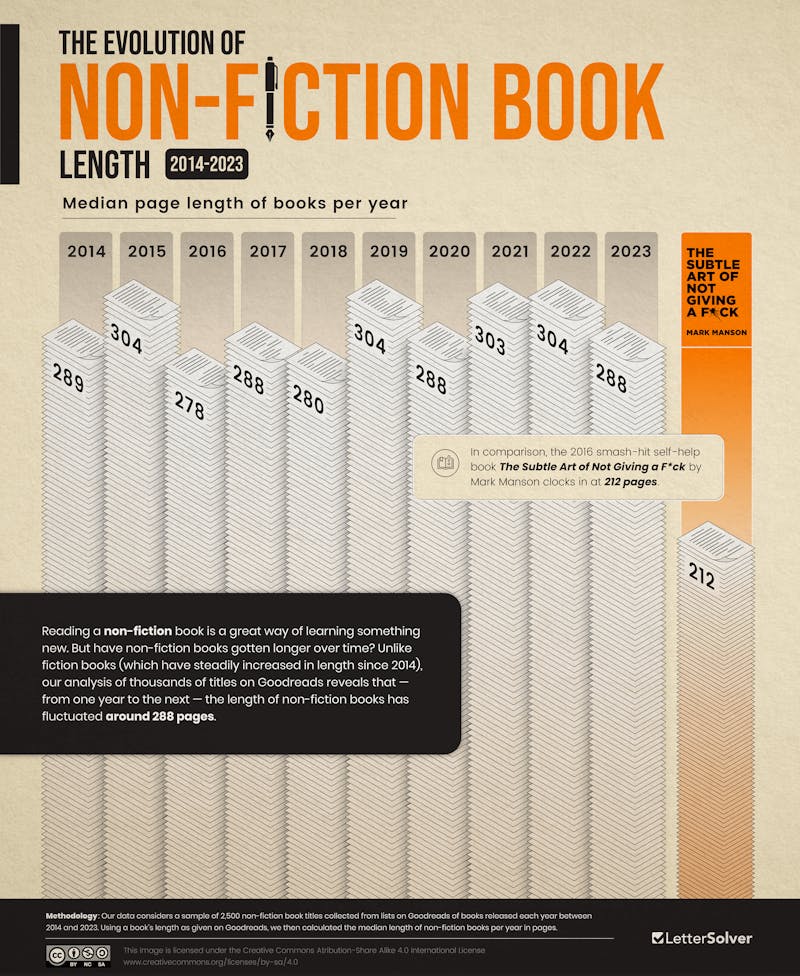
Romance Books Have Gained Over 50 Pages in Length
Now let’s dive into the different genres of fiction, and where sweeter to start than romance? Our analysis reveals that romance fiction books have gained an average of 53 pages over the last decade, from a median length of 314 pages in 2014 to 367 pages in 2023. In 2022, romance books saw the biggest growth in printed book sales of any genre, with data collector NPD citing BookTok — that’s the literary side of TikTok, for those of us not down with the kids — as a driving factor.
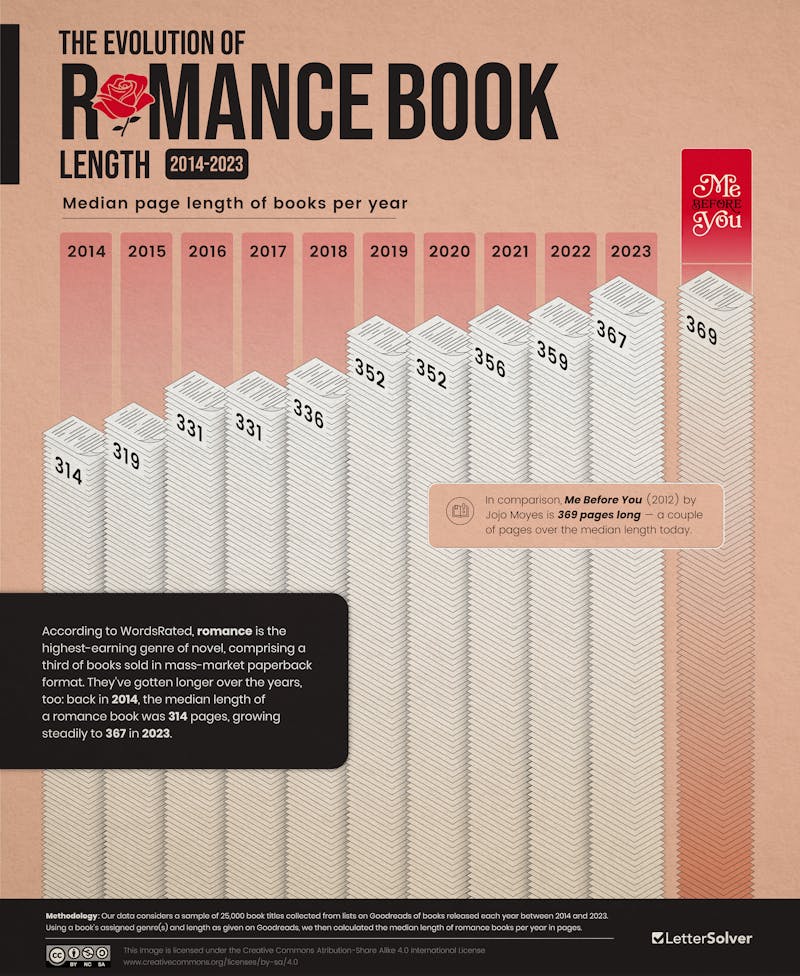
The Length of Science Fiction Novels Are in Flux (Capacitor?)
While romance books have seen a fairly steady upward trend in length over the last decade, science fiction books have been in flux. Back in 2014, the median length of a science fiction book was 351 pages, dropping to 336 pages in 2019. The average sci-fi book in 2021, however, was 381 pages long — the longest length of the decade — before dropping down to 368 pages in 2023. Perhaps 2023’s authors have looked to George Orwell’s seminal sci-fi work 1984 for inspiration, which also counts 368 pages.
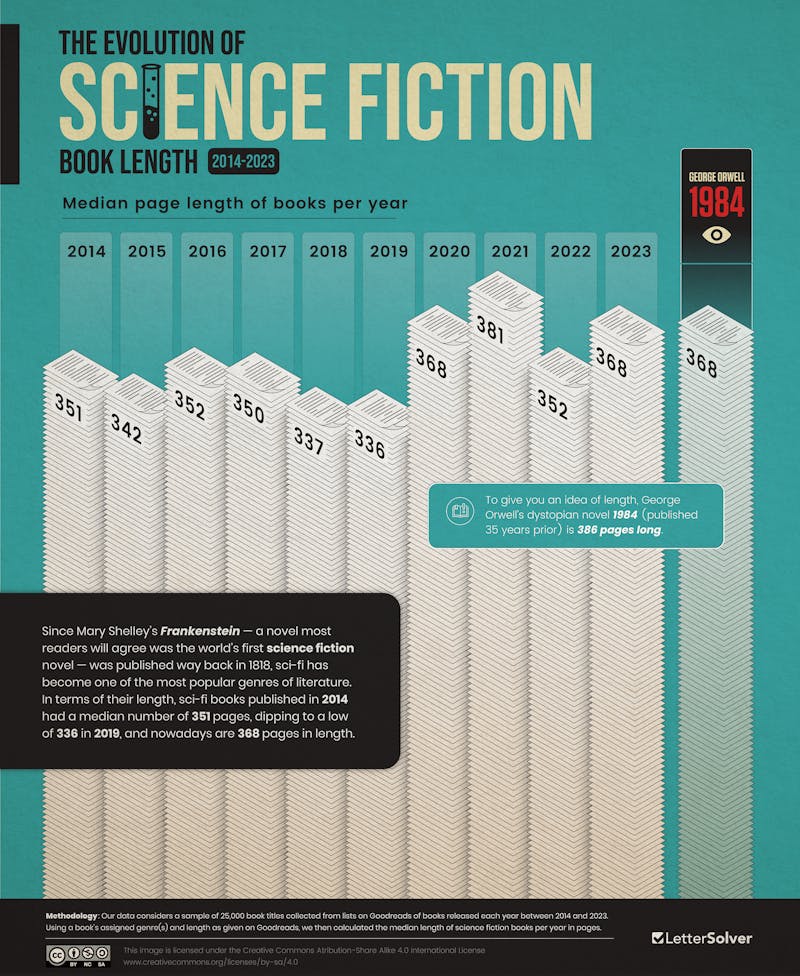
The Average Fantasy Novel Has Grown by 48 Pages
For a genre noted for in-depth worldbuilding, complex plotlines and busy casts of characters, it checks out that fantasy stories often can’t be resolved in just one neat book. Browse the colorful fantasy shelves in a library and you’re bound to see one series spread out over several titles, sometimes published years apart — a trend one writer laments as the “mega-novel.” Over the last decade, the average fantasy novel has gotten longer, gaining 48 pages between 2014 and 2023.
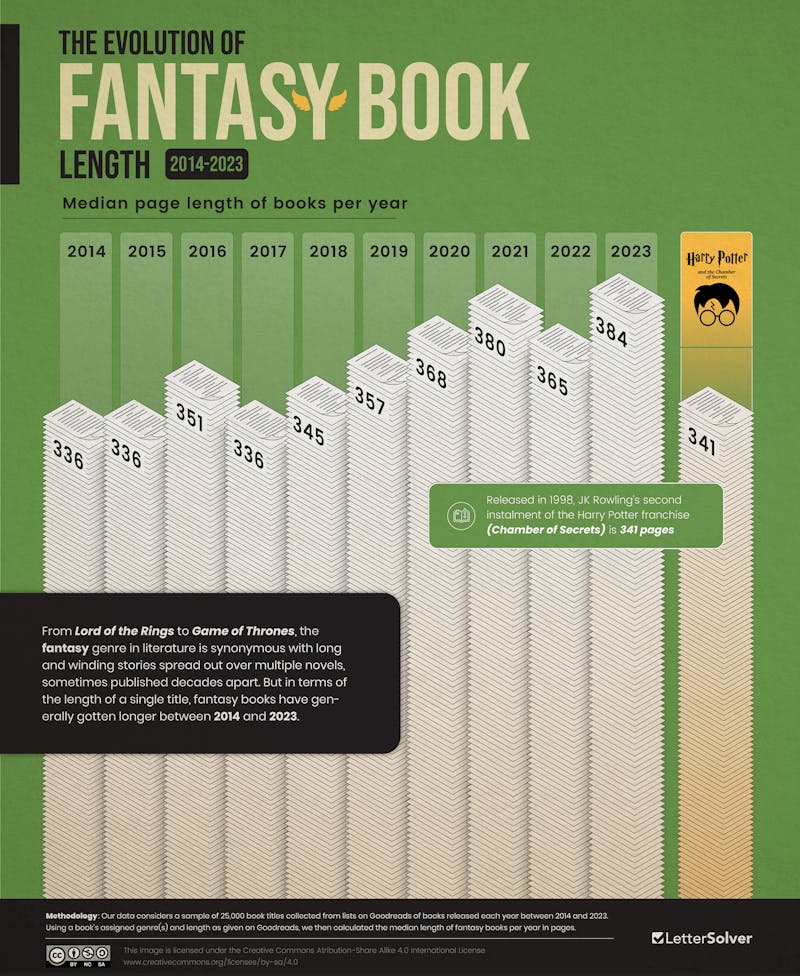
Crime and Mystery Novels Are Getting Longer
Crime novels like The Girl on the Train by Paula Hawkins (which clocks in at 336 pages long) are an irresistible slice of fiction. Prolific thriller author David Baldacci posits that it’s because “crime novels put the balance back in life … evil is punished, and the good guys mostly win, after solving the puzzle.” In terms of length, fiction books in the crime genre have gotten steadily longer over the years, starting from an average of 336 pages in 2014 to 351 pages in 2023.
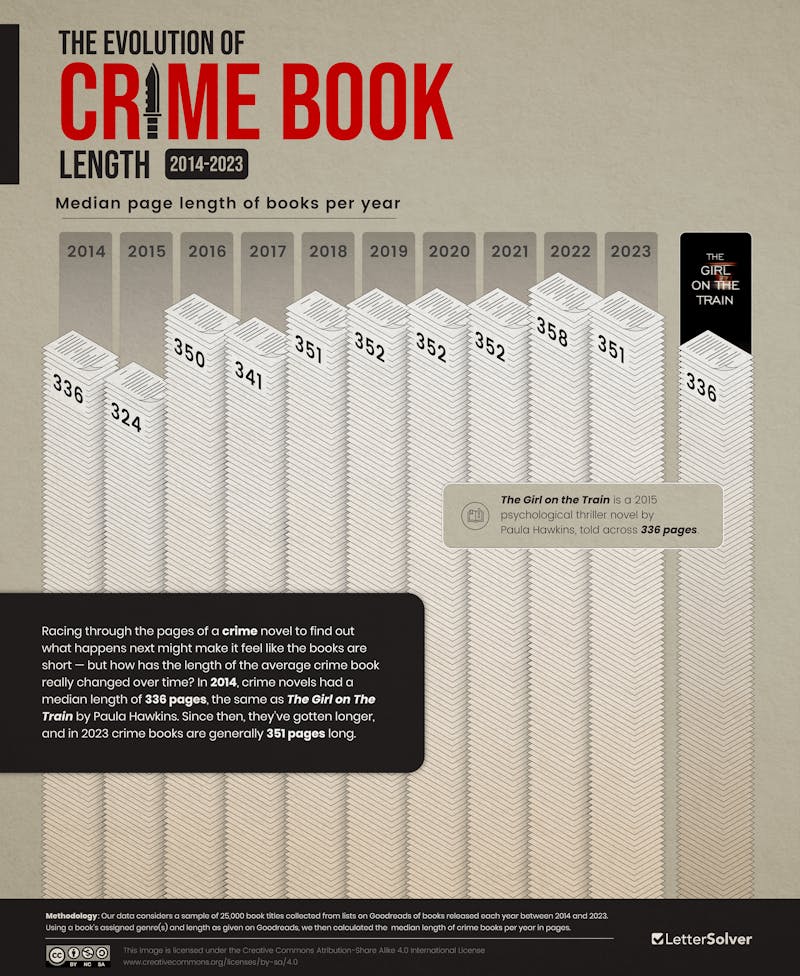
One of the hallmarks of the mystery genre (one of the most popular types of fiction among American readers) is standalone tales that follow the same protagonist as they solve page-turning puzzles. Case in point, Agatha Christie’s Hercule Poirot (the star of 33 novels) and the Jack Reacher series by the prolific author Lee Child, who writes 2,000 words a day. Like crime, the average mystery book has gotten longer in recent years, jumping from 336 pages in 2014 to 352 pages in 2023.
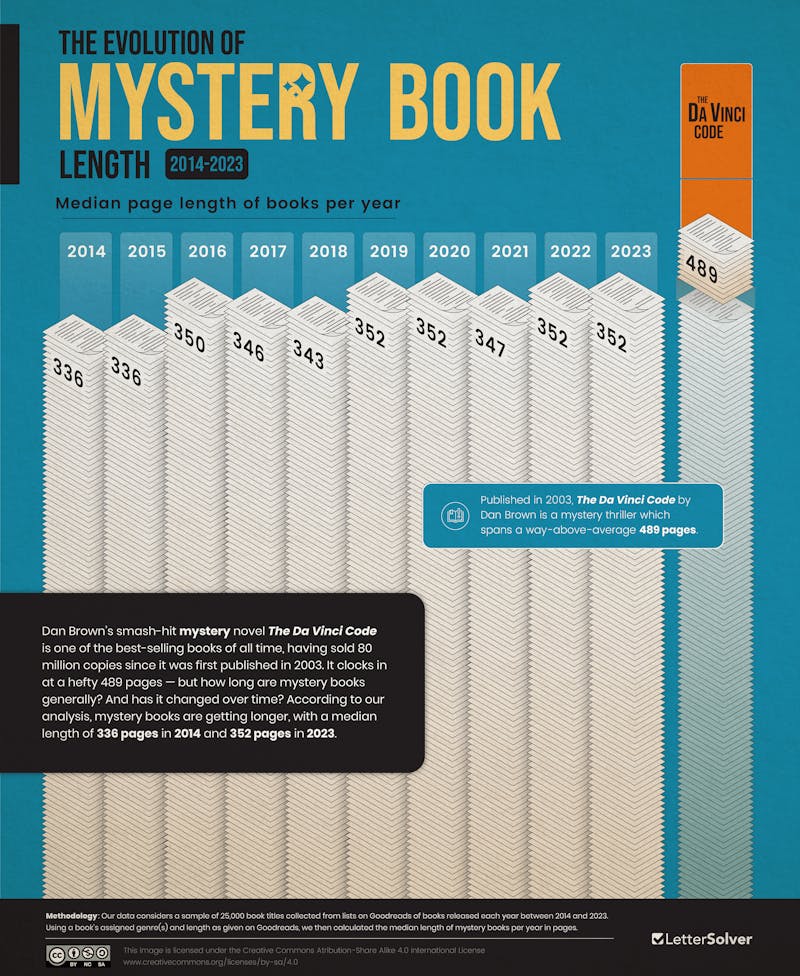
How Have Different Genres of Books Changed in Length Over the Last Decade?
From trendy self-help titles to ancient fables, one of the joys of browsing a library or a bookstore is the sheer number of types of books to explore. Whatever the genre, though, the odds are that the average book in 2023 is longer than one released in 2014; all but four of the book genres in our analysis have gotten longer, led by humor (+62 pages). Could it be that our appetite for funny reads has increased? In contrast, history books have lost the most pages (-40 pages).

How Have New York Times’ Bestsellers Changed in Length?
Making the prestigious New York Times Bestseller list is a unique achievement, reserved for just 0.5% of published titles — but have these books, in particular, gotten longer or shorter over time? In 2014, the average fiction bestseller was 372 pages long, the same number, coincidentally, noted by the book discussion podcast 372 Pages We’ll Never Get Back (inspired by the 2011 book Ready Player One’s length). After that, the average fiction bestseller has gotten steadily longer over the years.

But when it comes to non-fiction bestsellers on the exclusive list, our analysis reveals a fluctuating trend in length, with 2023 releases clocking up an average of 285 pages — the lowest number in ten years. Another study released in 2022 found that NYT bestsellers “have never been shorter.”
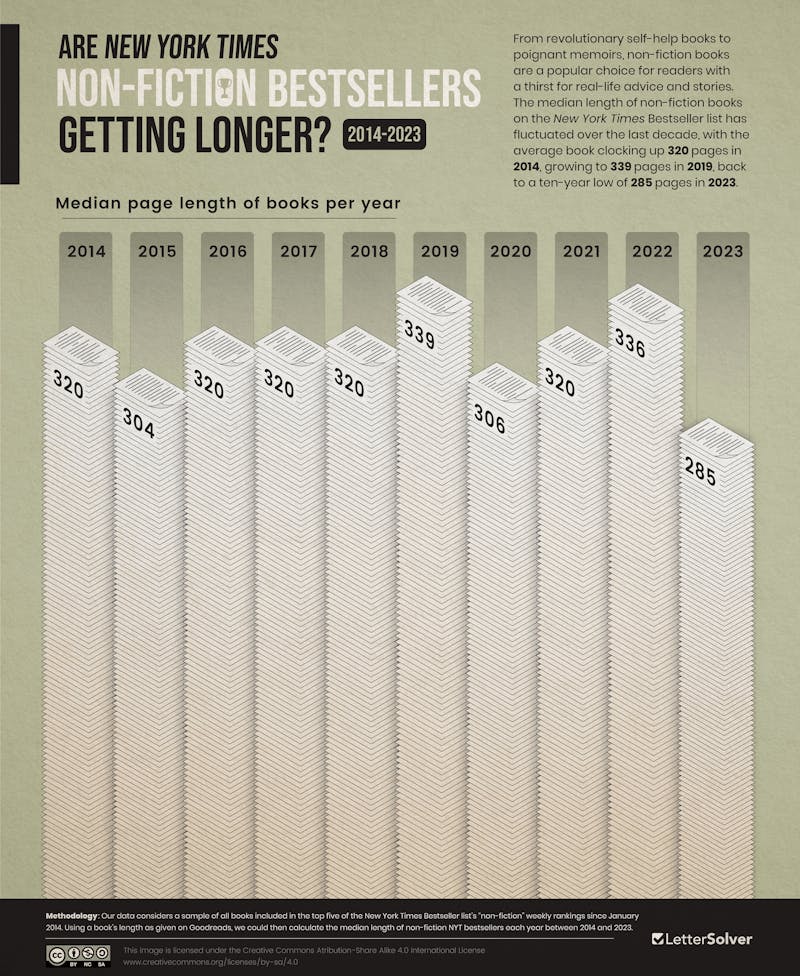
Finding the Time to Read (Whatever the Length of the Book)
When you lead a busy life, even the most passionate of bookworms can find it hard (or even impossible) to set aside time for reading. You’re not alone if that resonates — a Gallup study in 2022 found that Americans are reading fewer books than they used to. As the book critic Tim Parks lamented a few years ago: “Every moment of serious reading has to be fought for, planned for.”
So how can you make the time to get lost in a good book? The most obvious step you can take is blocking out some time in your diary for a good reading session. This could be while you’re on your commute or on your lunch break. Eliminating distractions is a surefire way to keep focused on the book in hand; that means turning off the TV and silencing your cell phone.
How We Did It
This project aims to understand the evolution of book-length in the last ten years.
To find how fiction, non-fiction and books of each genre have changed in length between 2014 and 2023, we first retrieved a general sample of over 25,000 books (22,500 fiction and 2,500 non-fiction) from Goodreads lists of books released each year from 2014 to 2023.
To find how fiction and non-fiction books on the New York Times Bestseller lists have changed in length over the years, we first retrieved every book that has been included in the top five of the New York Times Bestseller list’s “fiction” and “non-fiction” weekly rankings since January 2014.
Then, for every book in both lists, we sourced the page count and the applicable genres from Goodreads. Books were assigned to multiple genres if they were tagged as such.
Finally, we calculated the median number of pages for fiction and non-fiction books in both samples, as well as for the most common genres.
The data is correct as of August 2023.